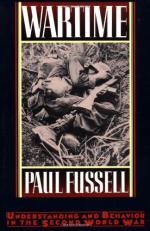
|
| Name: _________________________ | Period: ___________________ |
This test consists of 15 multiple choice questions and 5 short answer questions.
Multiple Choice Questions
1. Which of the following is an example of an official idiom first used in World War II?
(a) Scuba.
(b) Grunt.
(c) Radar.
(d) Destroyer.
2. Citizens were considered subversive if they did not participate in what efforts?
(a) Supporting the troops.
(b) Donating metal for munitions.
(c) Home gardening.
(d) Recycling.
3. What was the impact of the mainstream presentation of the war in the American media?
(a) It demoralized the troops.
(b) It invalidated the wartime experience.
(c) It hurt the war effort.
(d) It belittled the soldiers in the war.
4. Which of the following is NOT one of the elements that the author states to be missing from most venues during the war?
(a) Excellence.
(b) Dissenting opinion.
(c) Originality.
(d) Distinctness.
5. Overall, the reading experience of most citizens and soldiers could best be described as which of the following?
(a) Monotonous.
(b) Basic.
(c) Exciting.
(d) Challenging.
6. Most soldiers believed that their actual wartime experiences would be reported when?
(a) Long after the war.
(b) Never.
(c) Soon after the war.
(d) Only during the war.
7. What type of story is specifically cite as being very likely to be reported by mainstream media of the era?
(a) Detailed accounts of campaigns.
(b) Reports from allied bombing raids.
(c) Great victories.
(d) Biographies of individual soldiers.
8. Most soldiers had no knowledge of their purpose in regards to what?
(a) The operational directive.
(b) The big picture.
(c) Their unit.
(d) The local front.
9. Contrary to the media's presentation, the author believed that most allied victories were due to what factors?
(a) Air power and individual leadership.
(b) Skill and courage.
(c) Luck and boldness.
(d) Mass production and good strategy.
10. What was the impact of the relatively large number of books read by some servicemen during the war?
(a) It increased dissent and rationality in the enlisted ranks.
(b) Many became renowned writers.
(c) Many went on to seek higher education.
(d) It led to increased censorship.
11. Idioms were often adapted to what medium?
(a) Journalism.
(b) Advertising jingles.
(c) Poetry.
(d) Song.
12. Media outlets were concerned with the esprit de corps in what areas?
(a) Abroad.
(b) At the front and at home.
(c) In headquarters.
(d) In Europe only.
13. What was one innovation in book publishing that came out of the war?
(a) Mass publication.
(b) Paper-back books.
(c) Tight type setting.
(d) Movable type.
14. The term "Chad" originated where?
(a) England.
(b) Occupied Germany.
(c) America.
(d) Free France.
15. The author states that it was common for the media to suggest that individual soldiers died for what reason?
(a) The defense of liberty.
(b) Because of minor mistakes and chance events.
(c) To defeat Socialism.
(d) Due to his own failings.
Short Answer Questions
1. Public media took its cues from what source?
2. A typical soldier's amount of downtime would best be described as which of the following?
3. Most soldiers believed that the meaning and purpose of the war was which of the following?
4. What was the physical quality of most literary works produced during the war?
5. Which of the following best describes what the author believes about the US media's depiction of warfare?
|
This section contains 520 words (approx. 2 pages at 300 words per page) |

|




